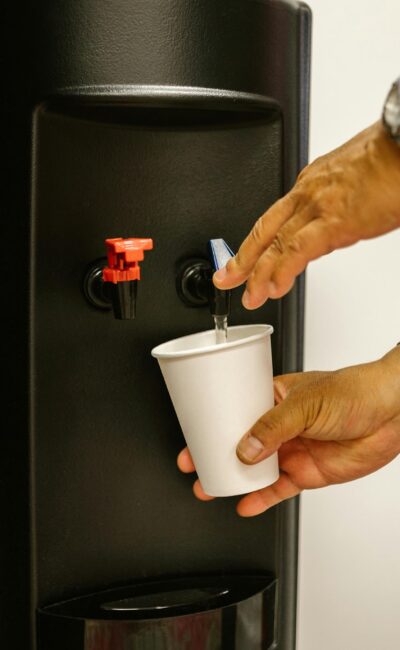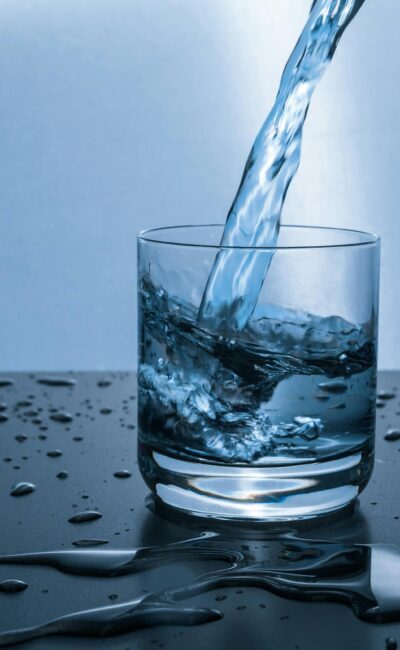The quality of your tap water varies depending on your location, water source, and how often the water is tested. Indicators of water quality include physical characteristics, such as odor and taste, while other factors can’t be seen by the naked eye. There are a range of contaminants that enter the original water source due to pollution and can make their way to your tap without being fully filtered out. Signs of water contamination to look out for include:
- Cloudy water or water with floating particles
- Unpleasant odor like chlorine or sulfur
- Unusual metallic or fishy taste
If you notice any of these signs, you’ll want to know what’s in your tap water, consider getting your water tested at home, and find alternative ways to get your daily hydration.
Cloudy Water
Cloudy water or the appearance of tiny particles often indicate a buildup of minerals that haven’t been properly filtered out by regular water treatment processes. While this lowered water clarity may not necessarily be harmful, it’s important to know if there’s a problem with the system or increasing levels of contaminants at the source. If minerals are making their way into your tap water, it’s likely that other pollutants and heavy metals are being passed through as well.
Unpleasant Odor
An unpleasant odor immediately decreases the desire to drink water from the tap. The two most common odors are sulfur or chlorine. Sulfates make their way through the soil and into your kitchen faucet, leaving behind a rotten egg smell. This smell is actually the result of a chemical reaction of sulfur with soil and rocks that creates what’s referred to as “sulfur bacteria.” According to the Minnesota Department of Health, it typically doesn’t indicate poor quality water, but the smell alone doesn’t make it pleasant to drink. Plus, it could signal the presence of other types of bacteria.
The other main type of odor people smell from tap water is chlorine. Chlorine is often used as a water treatment disinfectant, which at high levels, can prove harmful to health. Every municipality must follow contaminant levels recommended by the Safe Water Drinking Act, which regulates which levels pollutants and heavy metals can be included in drinking water and still be deemed safe. However, if your tap water has a weird odor, it could be an indicator that the levels are off.
Unusual Taste
In addition to odor, a strange taste is one of the main indicators of poor water quality. If your tap water has a metallic, bitter, or fishy taste, it could mean certain contaminants remain in the water at higher levels than what’s allowed. It could also be an indicator of rusted pipes that are leaching chemicals or toxins into the water as it makes its way from the original source.
Either way, as with smell, having something that tastes bad doesn’t make you want to drink it. It also signals an imbalance or problem in the water supply somewhere. It may not immediately mean the water is dangerous to drink, but the quality is low and hasn’t been treated properly.
Your public water system should notify you when there’s been a change in your city’s water quality. If there’s been a chemical spill or water sample testing that’s resulted in higher than usual numbers of contaminants and sediment, the city should let you know whether or not it’s safe to drink from the tap. However, when you notice something off about the water coming from your tap, it’s a good idea to explore further.
What Is the Criteria Used to Assess Water Quality?
The Environmental Protection Agency (EPA) has set National Primary Drinking Water Regulations that serve as the main standards and treatment techniques that cities must follow in order to protect the drinking water made available to the public. The EPA makes its determination about which pollutants are regulated based on their risk to human health.
It institutes guidelines on the level of contaminants, including microorganisms, organic matter, disinfectants and their byproducts, and inorganic and organic chemicals.
Though many contaminants are limited to a zero amount, there are several chemicals and toxins that pass criteria at low levels, such as chromium, cyanide, and mercury, among others due to pollution. There are also secondary standards that are listed that aren’t considered a risk to human health. However, these still affect the overall quality of the water through taste, odor, and sediment found in the water or water that results in spotting or staining. The metals that fall into the secondary standards category that may be present in your tap water include chloride, sulfur, iron, and aluminum.
Each year, community water systems must provide a Consumer Confidence Report (CCR) to their customers that lists in detail the quality of the water compared to the EPA standards. There are several pieces of information provided including:
- The water source
- Risk of contamination
- Level of regulated contaminants found in the water
- Actions the water system is taking to restore safe drinking water
This information may change between testing seasons and the distribution of the CCR, which means people may be susceptible to higher levels of contaminants than they initially are aware of. Furthermore, certain areas with high levels of contamination or water pollution may not be able to restore safe drinking water quickly, which leaves consumers without access to clean water for a prolonged period of time.
When Should You Have Your Water Tested?
Once you know what’s found in your tap water, there are still certain circumstances that may cause you to take the extra step of home testing or installing an at-home filtration system. The EPA suggests testing your drinking water supply if any of the following applies to you:
- Replaced or repaired pipes. Older homes with lead pipes or solders already carry a higher risk of contaminating your water, but the EPA suggests testing water annually for coliform bacteria, dissolved solids, and pH levels to ensure pipes are working properly and aren’t leaching any materials into the water. These may not be present at the water source when it’s tested but could be found in the pipes.
- New baby in the home. Contaminated water can carry detrimental health effects for women who are pregnant and their new babies since their systems are developing. Water that’s contaminated with lead or other chemicals and toxins can lead to birth defects and developmental problems for babies in their early stages of life. This is especially important to be aware of if you or someone you know is drinking tap water while pregnant.
- Environmental hazard. Homes near industrial plants or agricultural areas that have experienced a leak or problems with disposal may be at greater risk for toxins in the water body due to waste runoff seeping into the groundwater. Although you should be notified by your public water system whether the water is safe to drink, it’s a good idea to get it tested immediately following an incident if you plan to drink from the tap.
- Changes in your health. Water that’s been contaminated by coliform bacteria can lead to gastrointestinal issues and other side effects. Though symptoms could be indicative of a range of other factors, consider the quality of your water and if it may be the culprit.
Access to clean drinking water is a necessity. Unfortunately, many city water systems and changing environmental conditions can regularly change the quality of tap water, making it unsuitable for consumption. There are national, state, and city regulations set up to protect the quality of your tap water as much as possible. However, contaminants can still make their way into your water source based on where you live, how often your water is tested, the way it’s treated, and where the water is sourced.
Additionally, the age of your city’s water pipes and system play a part in what chemicals or toxins end up in your water as it flows from the source to your home. Fortunately, you can improve your water quality by transforming it with an attached filter faucet. In fact, we cover what to look for in a kitchen faucet in our kitchen faucet buying guide.
Improving Water Quality at the Tap
The FloFaucet is guaranteed to remove or reduce 80+ known contaminants from the water source, which means anything that remains in the water or gets picked up through the pipes is filtered out at the faucet. The water faucet filter captures contaminants, odors, and tastes that often decrease the quality of your water and leaves you with fresh-tasting, clean water instead.
By using a five-stage micro carbon block filtration process that works on most standard faucets, it’s a convenient way to purify tap water at the source and make it accessible to everyone. Plus, the FloFaucet is easy to install and simple to use, while also eliminating plastic waste. Many households currently rely on bottled water as an alternative to the tap. This negatively impacts the environment and is costly to maintain on a regular basis.
Recognizing the main indicators of water quality and knowing when another level of filtration is necessary ensures you’ll have the cleanest water available. Filter at the faucet to instantly improve the look, smell, and taste of your tap water and promote healthy hydration within your home. Trust your senses and rely on the technology available today that provides the extra treatment water needs to be safe.
Sources:
https://www.health.state.mn.us/communities/environment/water/wells/waterquality/hydrosulfide.html
https://www.epa.gov/ground-water-and-drinking-water
https://www.epa.gov/sites/production/files/2015-11/documents/2005_09_14_faq_fs_homewatertesting.pdf




